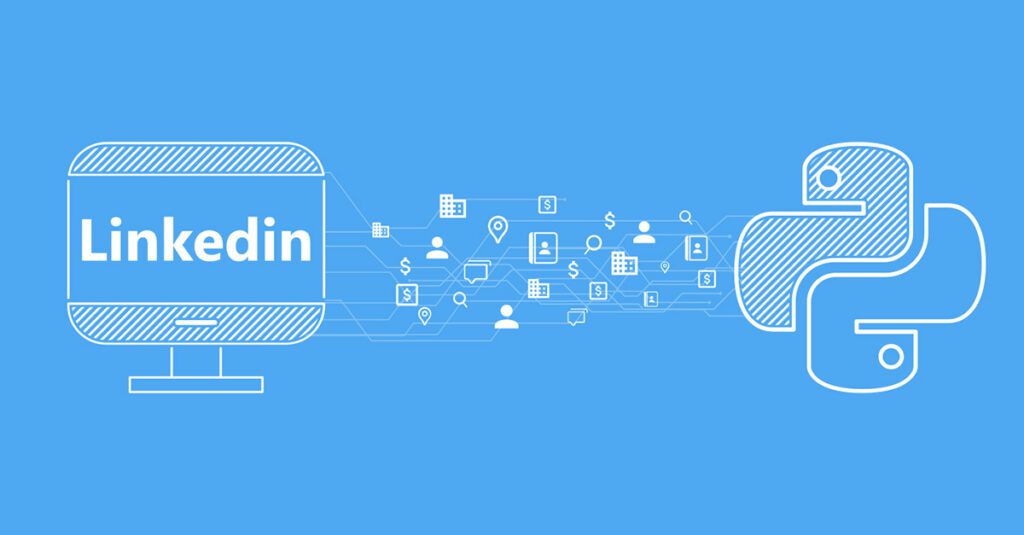1. Introduction
In today’s data-driven world, the importance of data cannot be overstated. Data analysis has become central to various fields such as business decision-making, marketing, and competitive intelligence. However, obtaining high-quality data is a challenge. LinkedIn, as the largest professional social platform globally, contains a wealth of career information, company data, and industry trends, making it an important source of data scraping. This guide will detail how to use Python to scrape LinkedIn data, helping you make full use of this valuable data source.
2. Business Applications of LinkedIn Data
Talent Recruitment
LinkedIn is a crucial platform for many companies to find and recruit talent. By scraping user profiles on LinkedIn, companies can quickly identify and contact potential candidates, improving recruitment efficiency.
Market Analysis
Companies can analyze LinkedIn data to understand market trends, competitor dynamics, and important industry developments. This data can be used to formulate market strategies and business decisions.
Competitive Intelligence
LinkedIn data can also be used for competitive intelligence analysis. Companies can gather key information about their competitors by scraping competitor company pages, job postings, and employee profiles.
3. Preparations for Scraping LinkedIn with Python
Setting Up the Environment: Python Version and Library Installation
Before scraping LinkedIn data, ensure that your environment is correctly set up. First, install the latest version of Python. You can check the Python version with the following command:
python --version
Then, install some necessary Python libraries, such as Requests, BeautifulSoup, and Playwright. You can install them using pip:
pip install requests beautifulsoup4 playwright
Introduction to Tools: Requests, BeautifulSoup, Playwright
- Requests: A simple and easy-to-use HTTP library for sending HTTP requests.
- BeautifulSoup: A powerful HTML parsing library used for parsing and extracting data from web pages.
- Playwright: A library for automating browser operations, capable of handling dynamically loaded content.
4. Steps to Scrape LinkedIn Data
4.1 Understanding LinkedIn’s HTML Structure
Using Developer Tools to Analyze the Page
Before scraping data, you must understand the HTML structure of LinkedIn pages. You can use the browser’s developer tools (F12 key) to view the HTML code of the page, identifying the containers and relevant tags of the data.
Identifying Data Containers and Related Tags
Using developer tools, find the HTML tags that contain the target data. For example, the user’s name may be in an <h1> tag, and the company name may be in a <div> tag. Record these tags and their class names or IDs for subsequent scraping.
4.2 Setting Up HTTP Requests
Writing Request Headers to Simulate Browser Behavior
To avoid being identified as a bot, add browser request headers to your HTTP requests. For example, you can simulate Chrome browser behavior with the following code:
headers = {
'User-Agent': 'Mozilla/5.0 (Windows NT 10.0; Win64; x64) AppleWebKit/537.36 (KHTML, like Gecko) Chrome/91.0.4472.124 Safari/537.36'
}
Using Proxies to Avoid IP Blocking
Frequent requests may lead to IP blocking. Using proxies can effectively solve this problem. You can use third-party proxy services or set up free proxy IPs.
proxies = {
'http': 'http://10.10.1.10:3128',
'https': 'http://10.10.1.10:1080',
}
4.3 Using Requests to Get Page Content
Sending Requests and Receiving Responses
Use the Requests library to send HTTP requests and get the page content:
import requests
response = requests.get('https://www.linkedin.com/in/some-profile', headers=headers, proxies=proxies)
html_content = response.text
Handling Request Exceptions
When sending requests, you may encounter network exceptions or server errors. Use a try-except block to handle these exceptions and ensure the stability of your program.
try:
response = requests.get('https://www.linkedin.com/in/some-profile', headers=headers, proxies=proxies)
response.raise_for_status()
except requests.exceptions.RequestException as e:
print(f"Error: {e}")
4.4 Parsing HTML with BeautifulSoup
Parsing Response Content
Use the BeautifulSoup library to parse the obtained HTML content:
from bs4 import BeautifulSoup
soup = BeautifulSoup(html_content, 'html.parser')
Extracting Required Data
Based on the previously identified data containers and tags, extract the required data. For example, extract the user’s name and company name:
python复制代码name = soup.find('h1', {'class': 'top-card-layout__title'}).text.strip()
company = soup.find('div', {'class': 'top-card-layout__first-subline'}).text.strip()
4.5 Handling Pagination and Dynamically Loaded Content
Writing Loops to Handle Multiple Pages of Data
Many LinkedIn pages are paginated, such as search results pages. Write loops to handle multiple pages of data.
for page in range(1, 5):
url = f'https://www.linkedin.com/search/results/people/?page={page}'
response = requests.get(url, headers=headers, proxies=proxies)
soup = BeautifulSoup(response.text, 'html.parser')
# Parse the current page's data
Using Selenium or Playwright to Handle JavaScript Rendering
Much of the content on LinkedIn pages is dynamically loaded via JavaScript. Use Selenium or Playwright to handle this situation.
Here is an example using Playwright:
from playwright.sync_api import sync_playwright
with sync_playwright() as p:
browser = p.chromium.launch(headless=False)
page = browser.new_page()
page.goto('https://www.linkedin.com/in/some-profile')
page.wait_for_selector('h1.top-card-layout__title')
html_content = page.content()
browser.close()
4.6 Storing and Using Scraped Data
Saving Data to a File or Database
Save the scraped data to a file or database for subsequent use. For example, save it to a CSV file:
import csv
with open('linkedin_data.csv', 'w', newline='', encoding='utf-8') as file:
writer = csv.writer(file)
writer.writerow(['Name', 'Company'])
writer.writerow([name, company])
Data Cleaning and Formatting
The scraped data usually needs to be cleaned and formatted to ensure consistency and usability. For example, remove whitespace and special characters:
python复制代码cleaned_name = name.strip().replace('\n', ' ')
cleaned_company = company.strip().replace('\n', ' ')
5. Precautions for Scraping LinkedIn Data
5.1 Complying with LinkedIn’s Terms of Service
When scraping LinkedIn data, you must comply with LinkedIn’s terms of service to avoid violating the site’s rules and risking account bans or legal issues.
5.2 Avoiding Triggering Anti-Scraping Mechanisms
To avoid being identified as a bot, take measures such as adding request headers, using proxies, and controlling request frequency.
5.3 Handling CAPTCHA and Other Verifications
LinkedIn may use CAPTCHA to block automated scraping. Use Selenium or Playwright to handle these verifications, or adopt more advanced anti-automation solutions.
5.4 Maintaining Data Legality and Ethics
When scraping and using data, maintain data legality and ethics, ensuring not to infringe on user privacy and rights.
6. Strategies for Coping with LinkedIn Scraping Challenges
Using Timers to Avoid Frequent Requests
Adding random delays between requests can avoid triggering LinkedIn’s anti-scraping mechanisms. For example:
import time
import random
time.sleep(random.uniform(1, 3))
Adopting Distributed Scraping to Reduce Single IP Risk
Using multiple IP addresses for distributed scraping can reduce the risk of a single IP being blocked. Use proxy pools or cloud servers to achieve this.
Using Browser Automation to Bypass Dynamic Content Loading
Use browser automation tools (like Selenium or Playwright) to handle dynamically loaded content and get complete page data.
7. A Better Option: Using Pangolin Scrape API
Introducing Pangolin Scrape API
Pangolin Scrape API is an API designed specifically for data scraping, providing automated, efficient, and easy-to-use scraping solutions.
Functional Advantages: Automation, Efficiency, Ease of Use
Pangolin Scrape API has the following advantages:
- Automation: No need to manually write complex scraping code, automatically handles data scraping tasks.
- Efficiency: Quickly obtain structured data, saving time and effort.
- Ease of Use: Simple API calls, easily integrated into existing projects.
Convenience: Get Structured Data Directly Without Writing Complex Code
Using the Pangolin Scrape API, you can directly obtain structured data, avoiding the complexity of manually parsing HTML and handling dynamic content.
8. Steps to Use Pangolin Scrape API
8.1 Registering and Setting Up a Pangolin Account
First, register for a Pangolin account and obtain an API key. You can register and set up your account through the Pangolin official website.
8.2 Choosing a Dataset or Customizing Scraping Tasks
After logging into your Pangolin account, you can choose predefined datasets or customize scraping tasks according to your needs.
8.3 Running Tasks and Monitoring Progress
After starting the scraping task, you can monitor the progress and status of the task through Pangolin’s console.
8.4 Downloading and Analyzing Data
After the task is completed, download the scraped data and use various data analysis tools for processing and analysis.
9. Conclusion
Scraping LinkedIn data with Python is a challenging task, but with proper preparation and strategies, you can obtain valuable data. This guide details the steps from environment setup, HTTP requests, HTML parsing to handling dynamic content, and the simplified method using Pangolin Scrape API. I hope readers can choose the appropriate scraping method based on their needs and make full use of LinkedIn’s data resources.
10. References and Resource Links
- BeautifulSoup Official Documentation
- Playwright Official Documentation
- Pangolin Scrape API Official Documentation
- LinkedIn Terms of Service
Through the above links, readers can get more relevant information and technical support, further enhancing the effectiveness and efficiency of data scraping.






